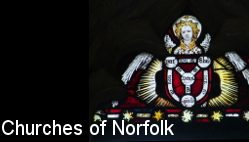| |
|
All
Saints, Toftrees
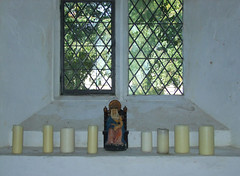 |
|
It
was good to come back to Toftrees on a hot sunny
day, because that was how I'd remembered it from
my previous visit. And this is in such a lovely
area of Norfolk, most of the churches open and
some of them stars in the Norfolk firmament. But
many are small, homely little churches like this
one, with an air of simplicity, and wholly
rustic. However, this is also an area notable for
interesting Norman fonts, not otherwise an East
Anglian speciality, and Toftrees has one of the
best. Unfortunately, unlike many of its
neighbours this is a church which I have never
found easy of access, so it was pleasing in 2013
to find that there was a keyholder notice at
last. All Saints looks delightful across
the fields, splendid in its isolation with only
the neighbouring farm for company. However,
closer to it is clear that the church is in
trouble, and indeed had declined since my
previous visit some five years previously. All
Saints is one of the last Norfolk survivors of
the Anglo-Catholic twilight, with statues and
candles abounding, but in truth it is in a very
poor state, the guttering falling, the brick
floors breaking up, and some window panes
missing. Bats have taken up residence in
considerable numbers. There is no village, and it
is hard not to think that this church is hurtling
towards redundancy.
|
I wondered
if All Saints had already gone the way of a number of
churches in this part of Norfolk, and was now disused,
earmarked for the headlong rush into abandonment and
desolation. But no, the kindly keyholder assured us that
the church was still in use. He unlocked the door and we
stepped inside, wincing at the heady stench of bat urine.
And there was the wonderful font. It is a riot of carving
with animal heads, including what appear to be a sheep
and a badger, geometric designs and, on one of the
original pillars, a representation of a Norman soldier
wearing a helmet with a nose-guard. Of course, all
churches once had Norman fonts, just as most Norfolk
churches once had round towers. It is theology, the
passing of the ages and of fashion which has replaced
them. A fine survival.
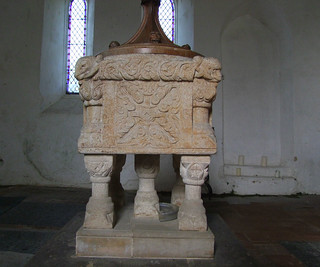
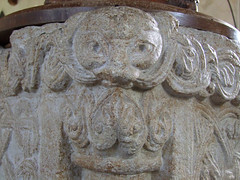 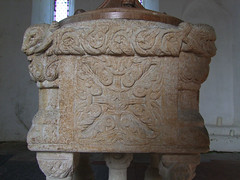 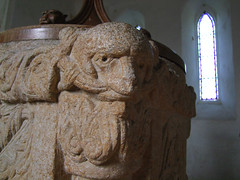
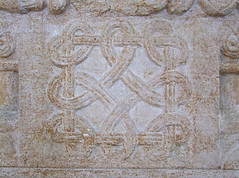 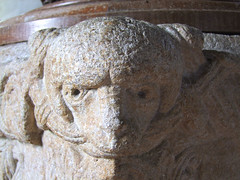 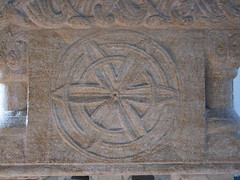
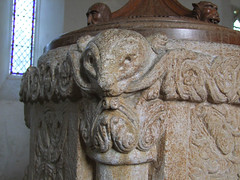 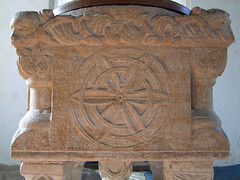 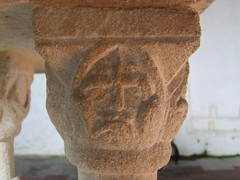
Even in
sunshine, the gloomy interior was full of the shadows and
ghosts of its Anglo-catholic past, now fading out of
sight. Looking to the west, the upper part of the
three-light west window had gone completely, and a
gusting summer wind was rattling the surviving panes. As
if to make a point, a small bird flew in through the
vacant pane, circled around and flew out again.
Outside, a
number of interesting 19th Century headstones bear
witness to the busy life of the past, but in fact
Toftrees has always been a tiny parish. At the time of
the 1851 census, when many East Anglian rural populations
reached their peak, there were fewer than a hundred
living souls here, and all the land was in the possession
of the Townshends of Rainham Hall.
| Now,
there is no village, just a few lonely farmhouses
and workers cottages. But All Saints is a
handsome church in a lovely setting, and its loss
would be a sad blow for Norfolk. What was
obstensibly a towerless Norman church was
developed in the 13th century and then
dramatically altered right on the eve of the
Reformation. The 16th Century chancel can be
dated to a bequest of 1506, and a further bequest
of 1523 gave materials towards the building of
the tower. But already it was late,
and the tower was never completed. Instead, it
was topped out about two thirds of the way up,
just below where the bell windows would have
been, and is today finished with a jaunty copper
cap. There is an endearing continental feel to
it, a most attractive sight, and I know that if
this church was open, and pilgrims and strangers
were allowed to explore it, All Saints would soon
become one of Norfolk's many much-loved churches.
|
|
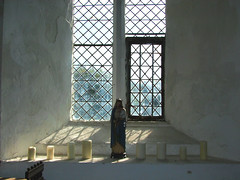 |
Simon Knott, January 2018
|
|
|
